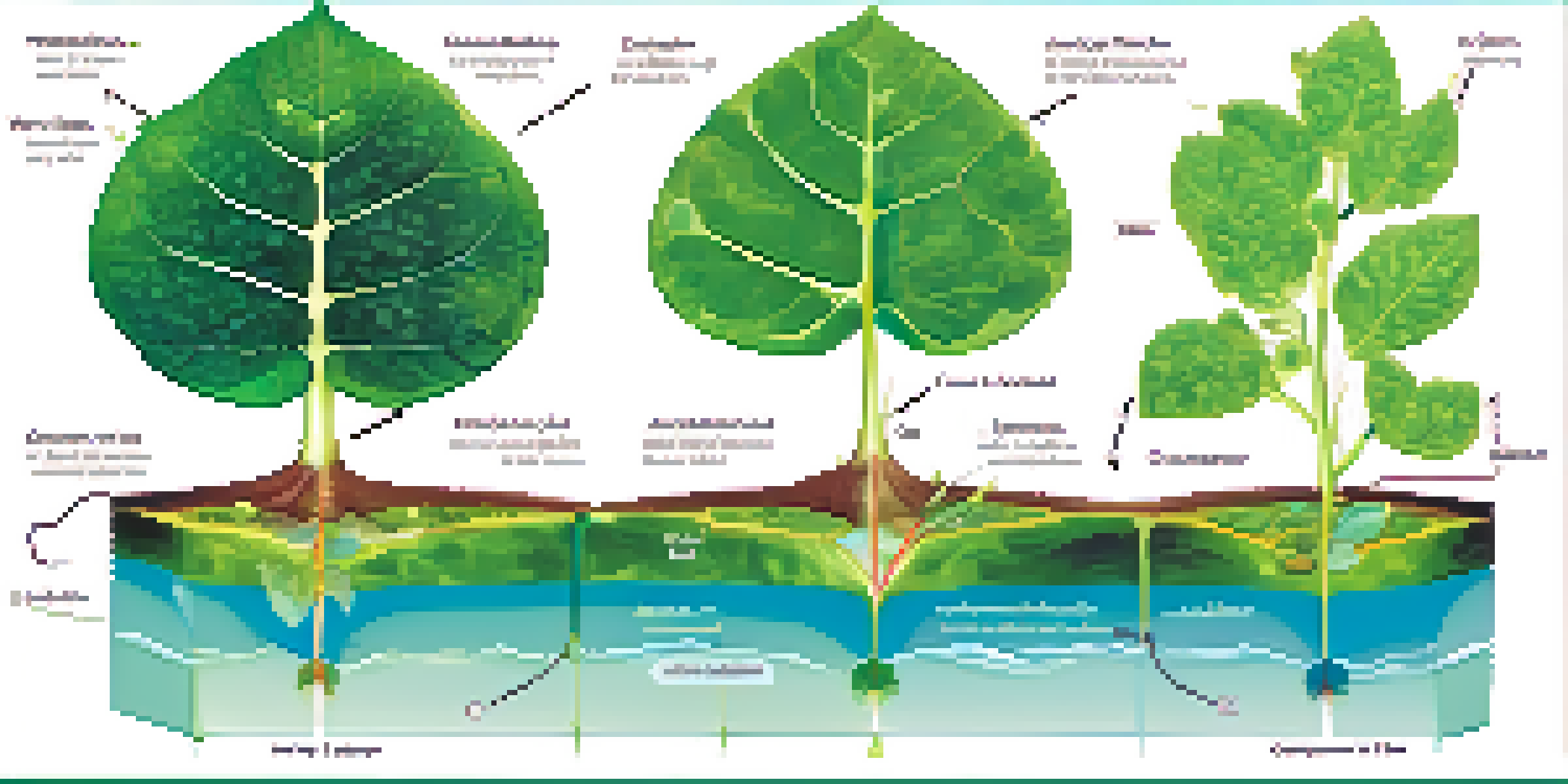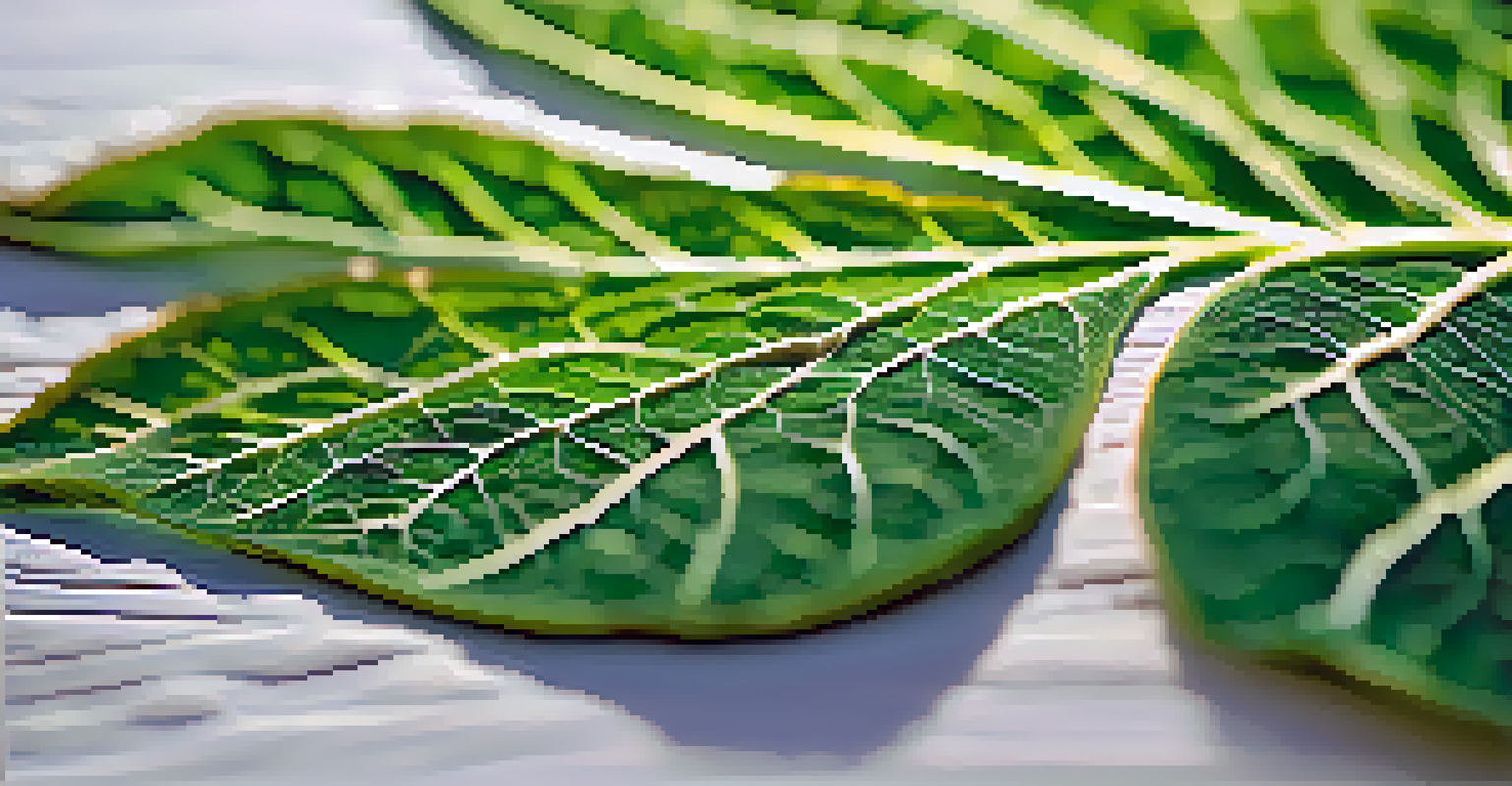The Role of Leaf Structure in Photosynthesis Efficiency

What is Photosynthesis and Why It Matters
Photosynthesis is the process by which green plants convert sunlight into energy, producing oxygen and glucose as byproducts. This process is not only vital for plants but also for nearly all life on Earth, as it forms the basis of the food chain. By understanding photosynthesis, we can appreciate its role in maintaining ecological balance and supporting life.
The clearest way into the Universe is through a forest wilderness.
At its core, photosynthesis occurs primarily in the leaves of plants, which act like solar panels. The leaves capture sunlight and utilize it to convert carbon dioxide and water into sugar and oxygen. This remarkable ability allows plants to thrive in various environments, making them essential contributors to our ecosystem.
Understanding how photosynthesis works gives us insight into agricultural practices and environmental conservation. With a clearer view of this process, we can explore ways to enhance crop yields and promote sustainability, ensuring food security for the growing population.
The Anatomy of a Leaf: Key Structures Explained
Leaves are composed of several structures, each playing a crucial role in photosynthesis. The outer layer, known as the epidermis, protects the leaf while allowing light to penetrate. Beneath this layer lies the mesophyll, where most photosynthesis occurs, consisting of palisade and spongy cells that maximize light absorption and gas exchange.

Chloroplasts, the tiny organelles found within mesophyll cells, are where the magic happens. These green structures contain chlorophyll, the pigment responsible for capturing sunlight. The arrangement of chloroplasts in the leaf optimizes their exposure to light, enhancing the efficiency of photosynthesis.
Photosynthesis: Key to Life on Earth
Photosynthesis is essential for plants and all life on Earth, forming the basis of the food chain and maintaining ecological balance.
Additionally, stomata are tiny openings on the leaf surface that regulate gas exchange. They allow carbon dioxide to enter and oxygen to exit, balancing the needs of the plant with environmental conditions. This intricate design showcases nature's efficiency in harnessing energy.
How Leaf Shape Influences Photosynthesis
The shape of a leaf, or leaf morphology, significantly impacts its ability to photosynthesize. For example, broad leaves can capture more sunlight, while narrow leaves reduce water loss—an essential adaptation for survival in arid environments. This diversity in leaf shapes illustrates the plant's evolutionary strategies to optimize energy capture.
Nature does not hurry, yet everything is accomplished.
In addition to size and shape, the arrangement of leaves on a stem, known as phyllotaxy, can affect light exposure. Leaves that are spaced apart allow for better light penetration, reducing shading and ensuring that each leaf gets adequate sunlight. This arrangement can be seen in plants like sunflowers, which turn to face the sun.
Ultimately, the relationship between leaf shape and photosynthesis efficiency highlights how plants adapt to their surroundings. By evolving distinct leaf structures, they can maximize energy capture while minimizing resource loss, which is crucial for their growth and survival.
The Role of Leaf Color in Photosynthesis
Leaf color, primarily due to the presence of pigments, plays a significant role in photosynthesis. Chlorophyll, the green pigment, is vital for absorbing light energy, particularly in the blue and red wavelengths. However, other pigments, such as carotenoids and anthocyanins, also contribute to light absorption and protect the plant from excess light.
When leaves change color in autumn, it's a sign that chlorophyll is breaking down, revealing other pigments. This process not only affects the plant's ability to photosynthesize but also indicates how environmental changes impact plant behavior. Understanding these changes can provide insight into plant health and ecosystem dynamics.
Leaf Structure Influences Efficiency
The anatomy and morphology of leaves, including their shape, color, and thickness, significantly affect a plant's ability to photosynthesize efficiently.
Interestingly, some plants have evolved to have reddish or purple leaves, which can help them absorb light more efficiently in low-light conditions. This adaptation showcases the incredible diversity of plant strategies to optimize photosynthesis and thrive in various environments.
The Impact of Leaf Thickness on Photosynthesis
Leaf thickness affects the rate of photosynthesis by influencing light penetration and gas exchange. Thicker leaves can house more chloroplasts, potentially increasing the photosynthetic capacity. However, they may also limit gas exchange, which is crucial for the process to occur efficiently.
For instance, succulent plants, known for their thick, fleshy leaves, are adapted to conserve water in arid environments. While these leaves may have a lower surface area for gas exchange, their ability to retain moisture allows them to continue photosynthesis even in dry conditions. This demonstrates the trade-offs plants face in different environments.
By examining leaf thickness, we can understand how plants have evolved to balance light absorption and water conservation. This balance is critical for their survival and productivity, especially in challenging climates where resources are limited.
Environmental Factors Affecting Leaf Structure and Photosynthesis
Leaf structure is not solely determined by genetics; environmental factors also play a crucial role. Light intensity, temperature, humidity, and soil nutrients can all influence how leaves develop. For example, plants in low-light environments may develop larger leaves to capture more sunlight, while those in bright conditions may produce smaller, thicker leaves to prevent damage.
Additionally, temperature can affect the stomatal density on leaves. In hotter climates, plants may develop more stomata to facilitate gas exchange, while in cooler areas, fewer stomata may suffice. This adaptability ensures that plants can optimize their photosynthesis according to their specific environment.
Environmental Factors Shape Leaves
Environmental conditions like light, temperature, and humidity play a crucial role in determining leaf structure and optimizing photosynthesis.
Understanding how environmental factors shape leaf structure helps us appreciate the resilience of plants. By studying these adaptations, we can apply this knowledge to agriculture and conservation efforts, promoting healthier ecosystems and sustainable practices.
Future Research: Enhancing Photosynthesis Through Leaf Structure
As we deepen our understanding of leaf structure and its impact on photosynthesis, researchers are exploring ways to enhance this process for agricultural benefits. By genetically modifying plants to optimize leaf structure, scientists hope to improve crop yields and resilience to climate change. This research could revolutionize food production in the face of growing global demands.
One exciting area of research focuses on creating plants with improved light absorption capabilities. By altering leaf morphology or pigment composition, researchers aim to enhance photosynthesis efficiency, ultimately leading to better growth rates and higher nutrient content in crops. This could be crucial for addressing food security challenges worldwide.

Moreover, understanding the relationship between leaf structure and photosynthesis can inform conservation strategies. By preserving plant diversity and their unique adaptations, we can maintain healthy ecosystems and promote sustainable agricultural practices that benefit both people and the planet.